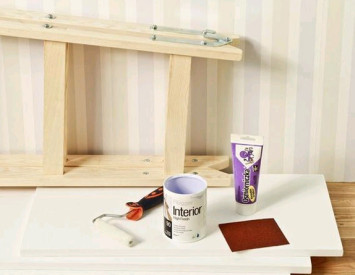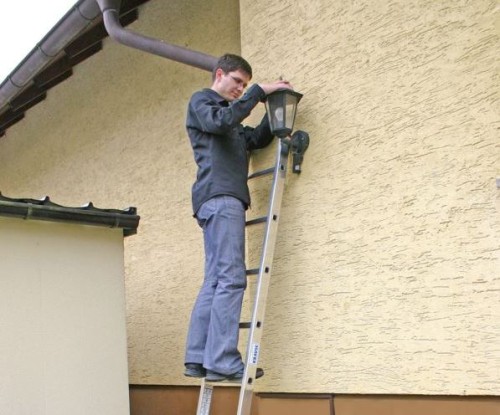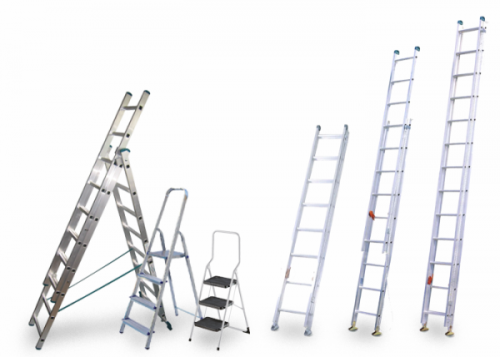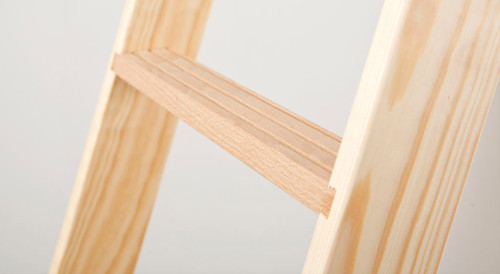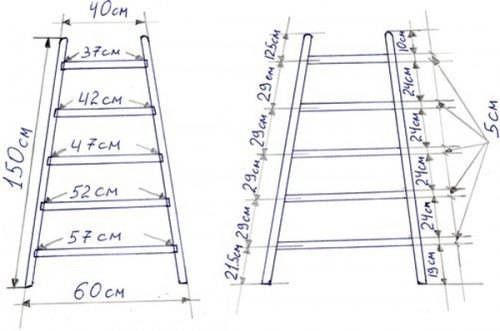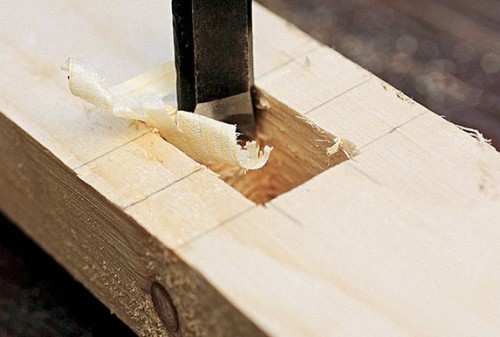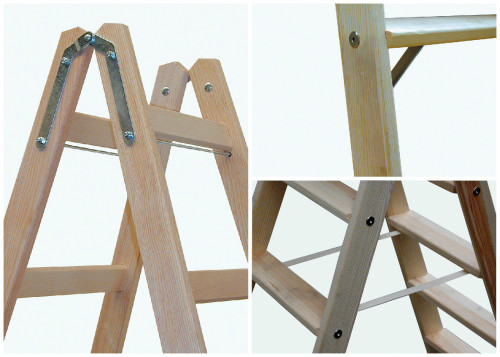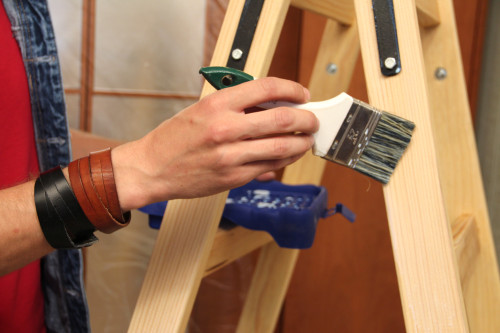In private farms, stairs are used for numerous needs, including not only stationary, but also mobile (portable) options. The ladder allows you to access various high -altitude objects in the process of construction and repair, it is convenient to rise on the attic or roof, remove fruits from high fruit trees. Today, a similar design is available in many yards. If you have not yet acquired a portable staircase, it can be made independently.
Content
The appointment of ladders
In the private economy, a convenient and reliable ladder is almost indispensable, as it allows you to get to places that you cannot reach from a height of human growth.
Such designs allow:
- make construction and repair, as well as finishing work on the facade of the building;
- perform windows, checking and replacing the wiring, installing counters and lamps, cleaning the drain pipes outside the building;
- harvest from high -haul branches of fruit trees;
- carry out check and current repair of roofing, inspect chimneys, as well as attic windows.
Thus, in many cases, you can’t do without a high -quality portable staircase.
Varieties of bailiff stairs
To carry out repair work, as well as housekeeping, it is convenient to use the premium staircase. Such a design of wooden bars, metal tubes or corners lean against the wall or wood at an angle of about 75 °.
The following varieties of ladders are presented on sale:
- simple non -devastated ones - are straight -line products of fixed length, consisting of support bowstring with steps fixed on them, which are attached in grooves or on the ribs of bowstring;
- folding - these designs from several sections connected by hinges can be stored in the room. Before use, such a staircase is laid out by acquiring the desired shape;
- sliding - ergonomic structures of two parts equipped with guides that provide light sliding. Section of these models are firmly fixed and withstand significant loads. The sliding ladder in a folded state takes up little space, it is convenient to transport and store it. On sale, sliding lightweight structures are convenient to use in the form of prefix aluminum stairs (such products are small in weight and are equipped with profiled steps that prevent sliding);
- stepmys are universal models that can be used to carry out any work outside the building, as well as in the limited space of rooms. On the site of the ladder-stairs, you can install the necessary tools and containers necessary for work.
Constructive requirements
In order for the ladder to be quite reliable and strong, when planning its design and in the process of manufacturing, a number of rules should be taken into account. Based on the calculations and tests performed, relevant regulatory documents were developed. In accordance with them, it is necessary to take into account the following recommendations and requirements regarding the constructive execution of such products:
- recommended ladder length - up to 5 m;
- to give the design of the necessary stability, special nozzles should be used, which can be removable. In the case of installation of the stairs on loose soil from below on the support racks, overlays with steel pins are fixed, which need to be buried in the soil. In order to avoid sliding side racks on a smooth solid surface, rubber “shoes” are put on them from below. For reliable fixation of the upper part of the bowstring, removable hooks are used;
- it is most convenient to move up the stairs with a step of 30-35 cm;
- the steps should not be left outside the support beams - for reliable fixation, they should be attached in the grooves of the bowstring;
- the support racks must be stained with below and from above, as well as along the entire length - with a step of at least two meters, special solid bolts;
- it is not allowed to use products with transverse cracks in wood, longitudinal should not exceed a depth of up to 5 mm and a length of up to 15 cm, while the weakening of the fixation of the crossbars or racks should be excluded. It is not allowed to close cracks with putty;
- metal structural elements should be devoid of burrs, sharp ribs and edges;
- sliding structures are equipped with a special lock, excluding spontaneous movement of the stairs. Stairs equipped with wheels are equipped with a castle mechanism to exclude their movement during work.
An annually should be checked by the ladder, even if it has not been used for this period. To do this, it should be installed at an angle of 65-75 ° and sequentially install a load from 120 kg on each step.
The materials used
For the manufacture of stairs, it is necessary to use durable and wear -resistant material. Regardless of the size of the ladder, it is required that the structure has not too much weight. Similar products made of metal (aluminum or stainless steel), wood are presented on sale. In addition, you can purchase structures of plastic reinforced for hardening with fiberglass - this light and at the same time durable material is characterized by chemical resistance and is a dielectric. The prefixed glass plaster can be used in production and in everyday life, since it is indispensable for the home wizard when connecting to the power supply source, repair or laying a new electrical wiring line on the site, in the house, in the attic.
At home, it is easiest to make a wooden ladder. For these purposes, coniferous wood (spruce or pine) is suitable. It is necessary to prepare durable, well -dried and even bars or logs without knots, distortions and transverse cracks. In addition, a tree with signs of decay and affected by insects is rejected. The wood used will be treated with antiseptic impregnation - this measure will protect parts of the structure from deformation and decay, and largely extend the service life of this device.
If you are interested in information on how to make a wooden ladder, you must take into account the following. The cross section of the bars should be selected depending on the length of the future staircase:
- from 4x5 cm - for lateral supports of stairs up to 3 m long;
- from 4x8 cm - for lateral racks of products with a length of more than 3 m.
For crossbars (steps), you should use bars with a cross section of at least 2x4 cm, otherwise the design will be too fragile. As a rule, sections of 3x4 or 3.5x4 are quite enough. It should be noted that too thick bars weighing the structure. For convenient movement, its width is enough on the stairs.
Types of fastening steps to the side racks
To connect the crossbars with the stairs of the stairs, the following fastening methods can be applied:
- the easiest option is the overhead installation of the steps - in such cases, the crossbars are fixed on top of the bowstring using nails or screws. Standing on such a staircase is on the edge of the bar, which is not very convenient. This design does not differ in special strength, and is suitable only as a temporary option;
- installation of steps in the grooves on the support racks - for this, the forms of the ends of the crossbar are cut out on the bowstring. Next, the crossbars are inserted into grooves and fixed using nails or screws;
- the “PAZ-Ship” connection-in this case, at the ends of the crossbars, spikes are formed, which are inserted into the grooves carved in the stairs of the stairs. This connection provides the most durable and reliable fixation of the steps.
How to make a bailry staircase with your own hands
A significant number of bailiffs are presented on sale - for household needs, use in construction and in factory conditions. Modern technologies allow you to use various materials for their manufacture, including metal hollow pipes or corners, as well as fiberglass. As a rule, such products differ in a significant price. For household needs, a simpler design is quite suitable, which is easy to make independently. On the Internet you can familiarize yourself with the schemes of such products and choose the most suitable option. Next, you will need to draw a drawing of the ladder, and then calculate the required amount of materials.
With your own hands, the following tools and devices may be needed for the manufacture of a ladder:
- chisel, hammer, as well as a screwdriver;
- roulette;
- carpentry pencil;
- plane;
- disk saw;
- grinder;
- electricity.
In addition, you will need to prepare two wooden blocks of suitable length for supporting racks, as well as wood for the manufacture of crossbars. For the construction of the stairs, it is preferable to use a well -dried pine beam - you should choose even bars without knots, braids, cracks and chips. This wood will need to be treated with an antiseptic.
Production technology of a ladder
Stage instructions on how to make a ladder with your own hands:
- In the presence of skills to work with carpentry tools, make parts for assembling the ladder is not difficult:
- first, you need to form two a bowstring from wooden bars with the same length, it is recommended to cut their lower edge at an angle to prevent sliding;
- next, for the manufacture of the crossbar, it is necessary to cut the bars into parts with a length of 60 cm. The number of steps is calculated based on the desired step height (usually about 290-350 mm);
- the angles of the parts should be rounded with a shirt or milling mill and sanded until a smooth surface is obtained.
- On a flat surface, lay the supporting racks of the stairs, having them in such a way that the distance between the upper ends of the beams is 40 cm, between the lower ones - 60 cm. Future a bowstring should be fixed in this position, temporarily nailed the plank on both sides.
- In accordance with the selected step of the stairs, apply the marking of the location of the crossbars to the beams.
- The steps must be adjusted along the length depending on the distances between the bowstring, and then numbered according to the location on the support beams.
- At the ends of the crossbars, it is required to form spikes, in the planned places for attaching steps on bowstring - the grooves of the corresponding form with a minimum clearance that allows you to perform installation with a tight fitting of parts. The grooves will need to be cut down with a chisel.
- The spike, as well as the groove is treated with carpentry glue. Next, the spike is wrapped with gauze or bandage in 1-2 layers, again smeared with adhesive composition, and then inserted into the groove. In this way, starting from above, it will be necessary to carry out sequential assembly of the stairs.
- Under the upper step staircase, as well as under the lower, it is necessary to drill through the through holes in the bowstring for installing fitting bolts.
- The bolts are inserted into the holes, fixed with nuts with wide washers placed under them.
- Next, the stairs should be covered with varnish or painted.
- If necessary, from below the support ends are put on the sliding pads - pins or shoes, you can fix special hooks on top for a more reliable fixation of the stairs.
How to make a folding ladder
The folding staircase is very convenient to use, it is used as a ladder. In folded form, such a design is characterized by compact dimensions, it can be placed for storage in the basement or in the attic. Its construction will require the same materials that are used in the manufacture of a simple ladder. In addition, it will also be necessary to prepare a nylon cord, connecting transforming mechanisms in the form of hinges, as well as steel bolts with nuts.
For the manufacture of a folding staircase, the same sequence of actions is first used as in the previous case - bowstring and steps are prepared and fixed with each other. It is necessary to make two identical sections (each of them can be the same width along the entire length or expanding down). After that, you will need to install tight bolts, and then cover the surface of the sections with varnish or waterproof paint. After this section, it is necessary to interfere with the hinges, fixing the joints with bolts with nuts. In order to limit its mobility when operating the stairs in the form of a ladder, several layers of a nylon cord or another limiter of the desired length (from a metal wire with a thickness of 8 mm or a wooden bar) should be attached to the bowstring.
After the installation is completed, it is necessary to test the reliability of the structure - for this, tests of the stairs in various positions should be carried out.
